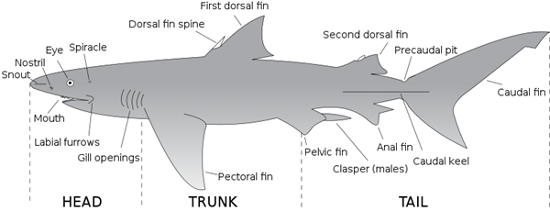Anatomy of a Shark!

Skeleton: Sharks belong to a family of fish known as Elasmobranchii, a subclass of Chondrichthyes, or in simple terms, cartilaginous fish. Chondrichthyes have skeletons made up of cartilage rather than bone, and lack a swim bladder. This particular class of fish contains over 600 species, including sharks, rays and skates.
Cartilage is lighter, more durable and more flexible than bone, contributing to Shark’s overall agility whilst also saving energy – vital when sharks must invest so much in constantly moving to prevent sinking.
Jaw: The jaws of sharks are not attached to their skull, instead moving separately with independent upper and lower jaws. This allows them to lift their head and thrust their mouth forward to bite its prey. While this varies among different species, most sharks have this ability to some degree.
Due to the sheer stress that this area of the shark is likely to experience, the surface of shark’s jaws have extra support in the form of tiny hexagonal plates called ‘tesserae’ – calcium salt deposits which give shark cartilage more strength. Often there is just one layer of tesserae, but larger sharks such as the great white shark have three or more layers.
Teeth: Sharks may have up to 3,000 teeth at one time and are fully embedded into the gums, as opposed to being directly affixed to the jaw. The shape and size of the teeth vary depending on their purpose, and there are four main types of shark teeth:
Needle-like teeth are typically found in sharks whose diet consist of small to medium sized fish, or even other small sharks. They are particular effective at gripping onto agile and slippery fish.
Serrated, wedge like teeth are found in larger species that feed on larger prey, and are effective at cutting off chunks of flesh for easy swallowing. The great white shark is a prime example of a specie with this feeding habit.
Teeth which serve no purpose at all are found in plankton feeders such as the basking and whale shark, who use their gills to filter feed.
Dense, plate like teeth are used to crush the shells of prey like bivalves and crustaceans, and are found in smaller sharks such as the nurse or angel.
Sharks continuously grow multiple rows of replacement teeth in a groove inside of the jaw, and are usually replaced one at a time as opposed to entire rows. It is estimated that some sharks may lose 30,000 or more teeth in their lifetime, with replacement rates varying from several days to several months.
NORTH SHORE SHARK ADVENTURES
Haleiwa Harbor
66-105 Haleiwa Rd
Haleiwa, HI 96712
Call 808.228.5900


